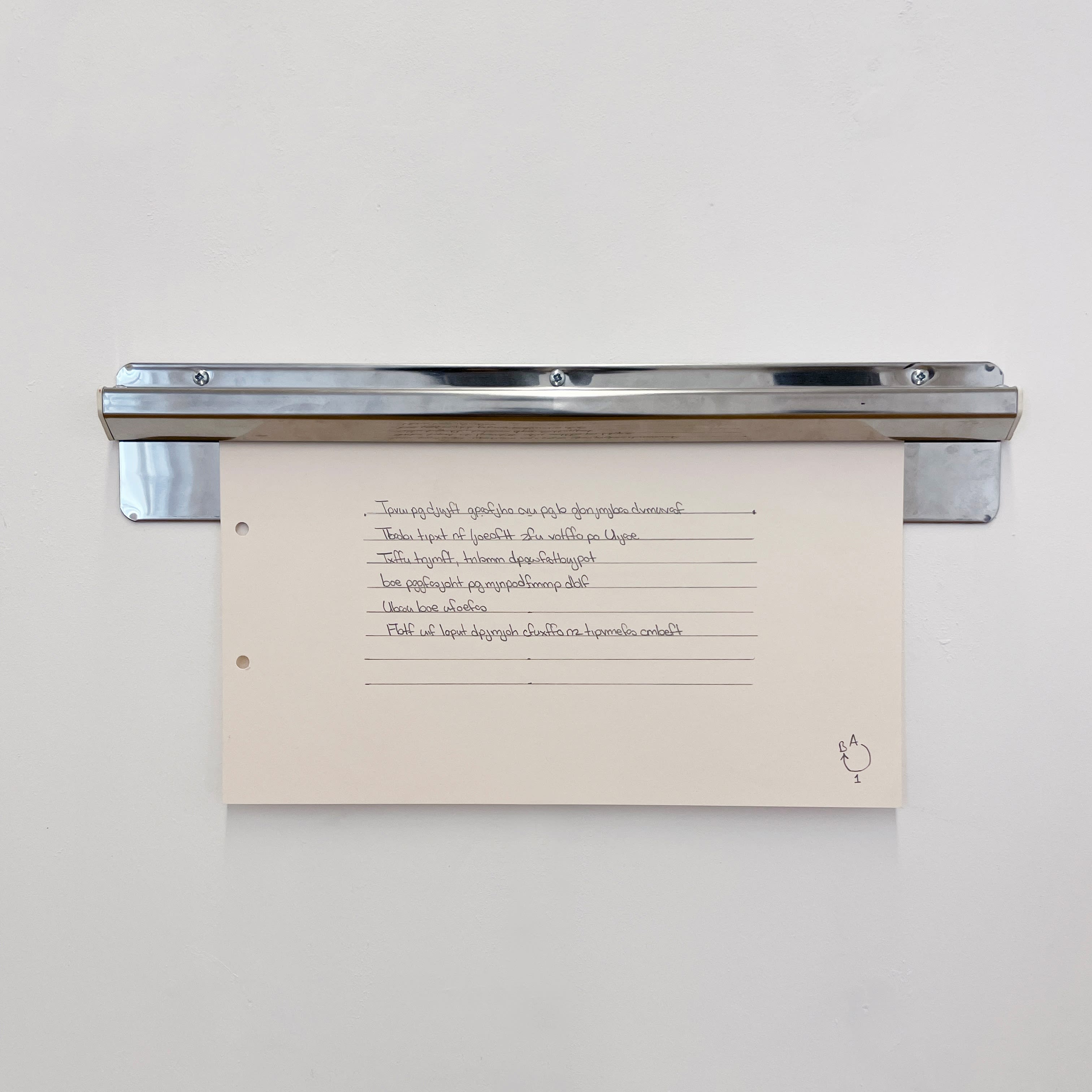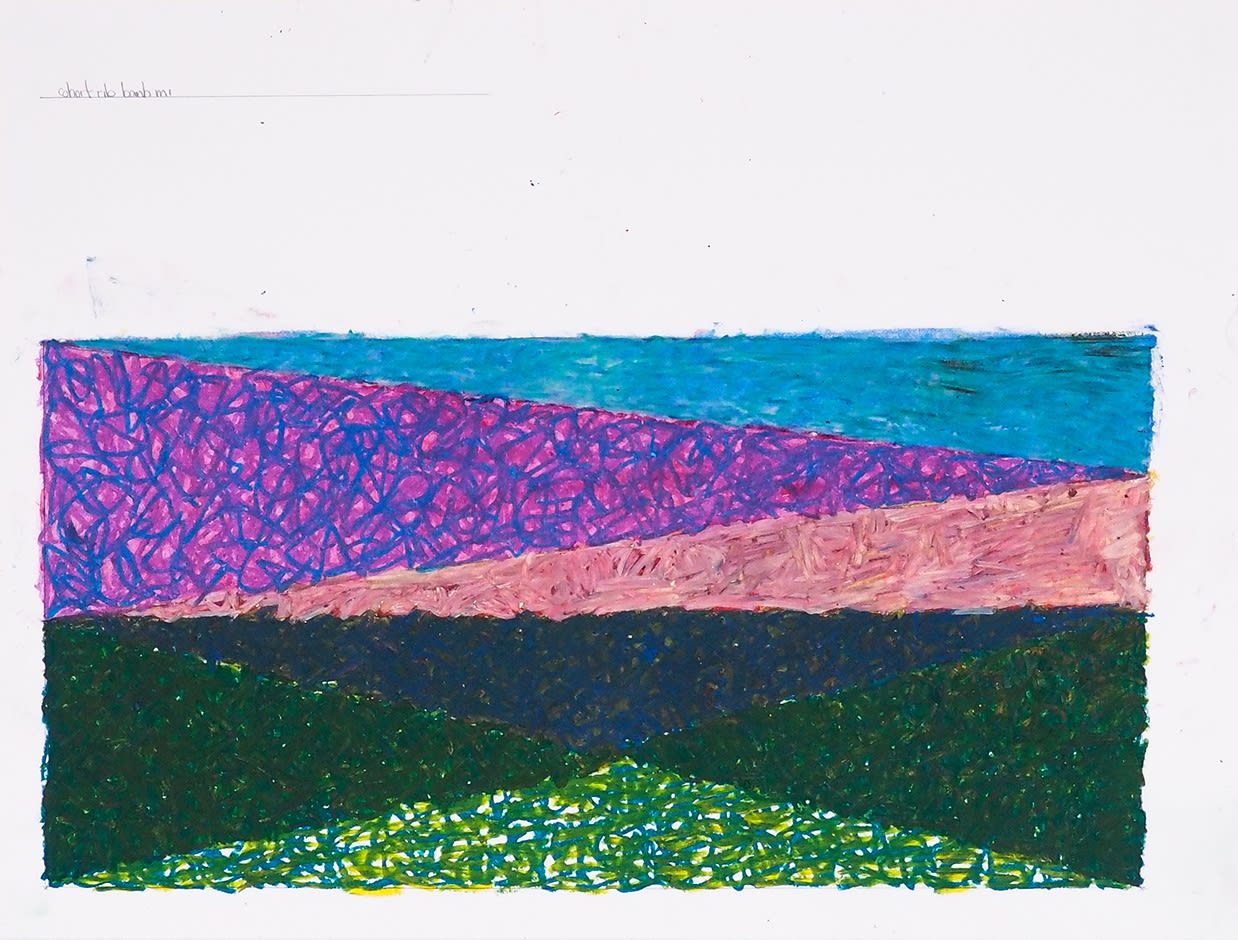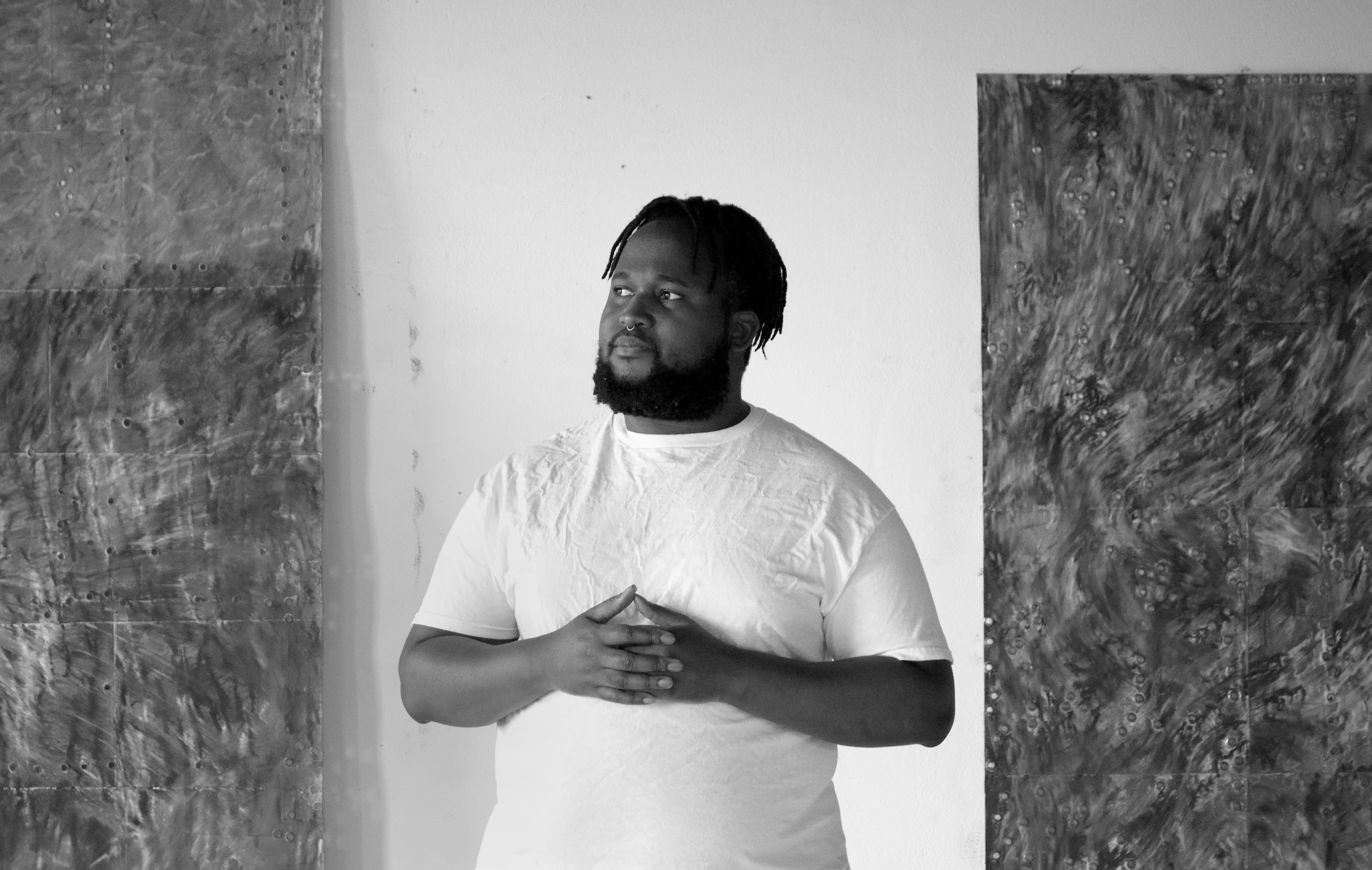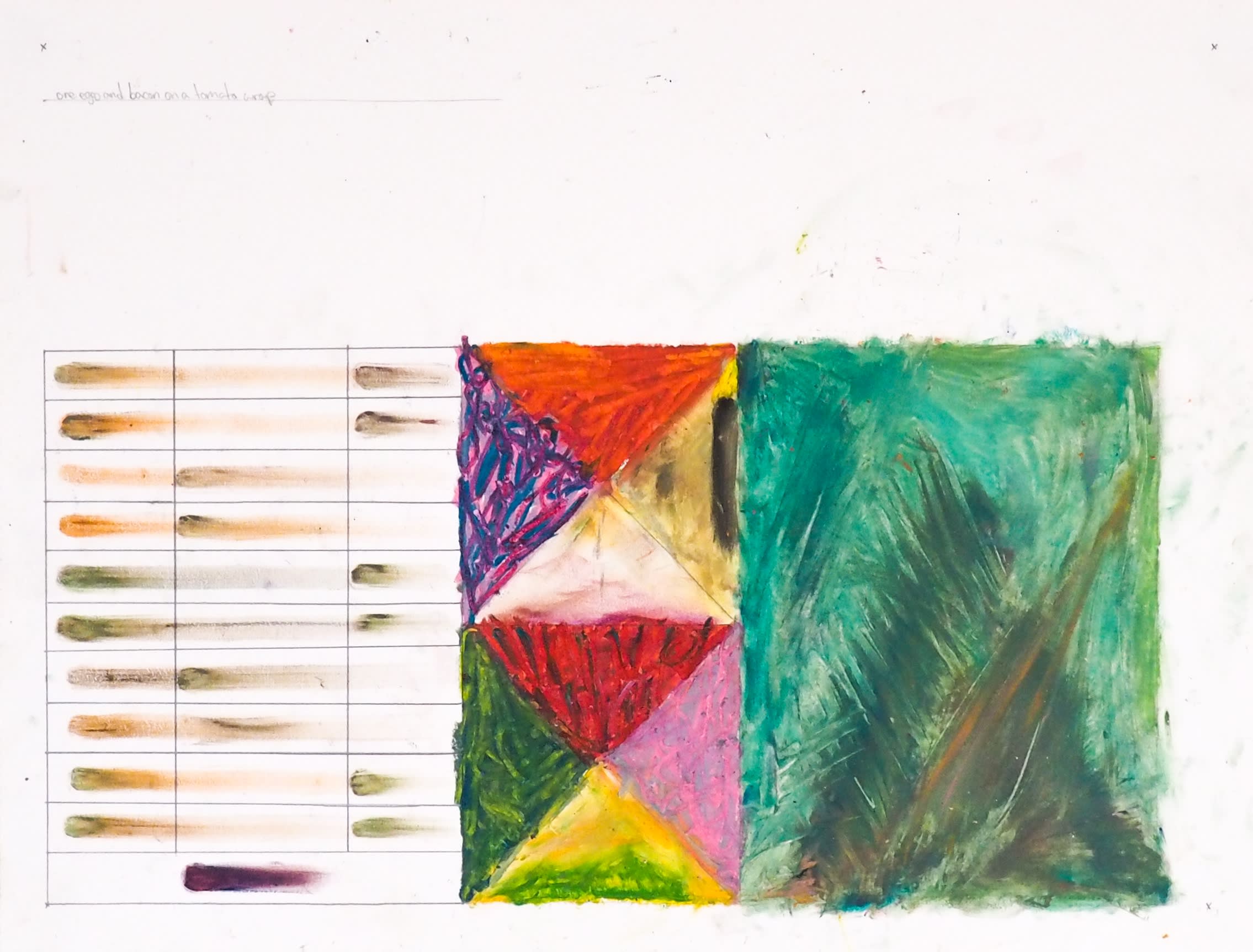
Color, mark making, and the codes of culture: you have referred to those elements in your work to be deciphered, with your most recent works and the accompanying Ceaser Cipher texts. What is your interest in creating visual codes that must be traversed?
I associate the use of ciphers to code switching. I’m a Black individual. I grew up in a Caribbean household. The way I would speak to my mother and close family members is very different to how I would speak to my partner from Sierra Leone, to white folks on the street; the way I would speak to someone who is not Black. Code switching is something that you just naturally employ as a Black individual because the reality is that being Black is associated with a lot of precarity. The ways in which you navigate certain spaces have to change so you can circumvent that precarity. I’m trying to obfuscate the immediate initial read of the text that I’m producing for each of these paintings.
When thinking about those aspects of precarity and needing to code switch depending on the environment, especially within the context of the last few years where Black people are getting killed left, right, center all across the world; I see how easy it is for people to say, “Black Lives Matter” and use social media as a way to position themselves in solidarity. So, I ask myself: Where is the actual labor? So, for me creating these obfuscations meant to be deciphered within the context of an exhibition space, is me placing this aspect of labor before the viewer. Within these art spaces, you don’t see a lot of Black people, so I am setting those parameters up to a non-Black audience where they have to do that labor. There is information within the text that serves to enrich the paintings. I’m happy to share the paintings. I love painting and that being accessible to people but these other bits of information that you have to work for; I have a right to ask for that labor.
Are you interested in giving an insight of the experience of code switching within the Black experience to the art world audience?
It’s not for me to give people an insight into the Black experience. If you are going to engage with my work, I would just like you to do the work. It’s easy enough to look at a painting and consume it but I don’t see abstraction as being sterile. It’s important for me to work against this idea of a purist practice. There’s a lot of baggage that I carry within my painting practice and how food is so tied with my cultural identity. As a Jamaican who was born and grew up in the United States, and thinking about those jostlings of culture, I deal with that in the context of my painting practice. It’s really important for me that there be a slow read. The slow read of a painting is like the slow cook of a meal. I’m pulling labor out of the viewer and through that, also teasing out a level of care in the engagement with the work. Your relationship to the work becomes that much more enriched. It’s like reducing the juices in a pot of stew. The longer you take with it, it just becomes that much more intense.

 Kemar Wynter, Limoncello Cake, 2021, Oil pastel, polyvinyl alcohol and grommets on French cardstock, graphite on French cardstock, stainless steel ticket holder 83.8 × 83.8 cm / 33 × 33 in
Kemar Wynter, Limoncello Cake, 2021, Oil pastel, polyvinyl alcohol and grommets on French cardstock, graphite on French cardstock, stainless steel ticket holder 83.8 × 83.8 cm / 33 × 33 in
How do you see a correlation between your exploration of coding to the mark making language you develop through your works?
I don’t necessarily associate coding with the mark making in my paintings. I understand the association but the mark is part of the synthesis of each dish; not necessarily a matter of establishing a code. There isn't a set structure in the way that my oil pastels get built up from surface to surface. The grommets are another circumstance altogether. Paredolia, our human tendency towards building patterns out of irregular arrangements is so prevalent in the way we see. As these works have continued to mature, I´ve learned that a few carefully placed grommets around the surface can create a sort of visual armature that forces the eye to continually be guided around the dimensions of each surface in a sort of extended loop.
You often discuss building up your works. Always working from the last mark you’ve made, to decide the next. Would you describe that as creating a sort of code itself? Every art work having its own code, its own visual language, so as to speak a specific narrative?
The paintings are made incrementally. The writing is the foundation for this body of work so it’s from the text I initially start out with that I’m able to pull two or three colors with which I can then start building up the surfaces. After that it becomes largely intuitive. These paintings aren’t singularly about the dishes themselves but the experiences surrounding them. Growing up in the kitchen was where you had all of your conversations. You do your family check-ins there. It’s not about the actual depiction of the food but condensing that moment to a color or a gesture. One thing that I’ve been curious about ciphering is the idea of legibility and how you can take something that is originally legible and through a cipher it becomes illegible. I’m curious to see how those letterforms turn into gestural marks. There’s so much action that happens to the wrist when you are writing; it becomes its own gestural mark making process. Within the larger paintings, there are these larger sweeping gestures that capture your eye across the composition alongside the grommets that become that patterning within the work. There is a shift of scale that happens between the two that I think is pretty fascinating and I will continue to tease it out.

Kemar Wynter, ZZ41 (Short Rib Banh Mi), 2020, Graphite, oil pastel on French Card paper, 48.3 × 63.5 cm / 19 × 25 in
Memory is a very big part of your exploration of identity. The sensory experience as well. They seem to develop as a visual landscape. When using certain marks or colors, are these intended to also be visually related to the geographical landscapes you refer to?
Aside from the kitchen and the dining room, these areas where these dishes are happening, I’m not fully thinking about places during the process. I get those associations down in the initial writing phase and then I just get into the painting. I don’t want them too tied down to the experience itself. There’s a point in which I am making a painting and the painting stops me, tells me what it needs, and I respond in return, and I can intervene and add more elements. It’s about understanding what the surface desires versus what my intentions are. For me, when it comes to finding a stopping point in a work, it’s usually based on a feeling.
 © Kemar Wynter, Image: Kyle Hobratschk
© Kemar Wynter, Image: Kyle Hobratschk
The way you talk about your work process is so distinct to what we talked about labor and this American capitalistic way of working. Your process is more organic and natural; is there something to that?
It’s one of those things where it’s related to simply relishing cooking. I come from a very large family. Cooking was the time we used to unwind. For my family and I there really isn’t this notion of capital. This is something that we do out of love and genuine care. Time be damned. That had nothing to do with the output of a meal. So, allowing myself to have that time to be in the studio is gleaned from those moments in the kitchen watching my mother and my aunts prep dishes and helping them with little things until I was old enough to handle things on my own. I’m probably the slowest cook in the family. I like to be very intentional to the minutiae of the dish itself in a way that is gratifying to me. More than anything else, I’m really interested in pleasure that someone can derive from making and being able to share a dish with someone I love and care for.
While your work can be very personal, it also touches upon collective cultures that are very much intertwined with Black history, particularly in America. Can you tell us more as to the importance of elevating the home experience, the domestic life that is often passed from generation to generation, and paying homage to it?
Above all else, I make my work for Black people. The most natural way for me to make my work is to focus on the things I know the most. There are certain core moments in your life that end up being very integral to the ways in which one builds up a practice. You can try to fight against that, but for me it just feels more honest to go with the things that are heavily tied to who I am as a person. When it came time to go to college, I was either going to go to culinary school or art school. I could’ve decidedly done either. I’ve always been interested in focusing on the things that have been very nourishing to my upbringing. These core crucial elements that have served to formulate my identity and this notion of self that I have. I think I have a responsibility to think about my practice as an archive. Especially having been the first person in my family to have been born in the States- It’s important for me to hold on to all those culinary elements from those generations of my family being in Jamaica. All the implications of slavery, racism, colorism – all the ‘isms’ that are associated with that and are heavily tied to cuisine. As long as I continue to make work, I’m always going to be focused on those core ideas of home. Those core ideas of what it means for me to be Black, Jamaican, and also living in the United States. I think about the ways in which I can take those elements forward and bring them forward with me through history. It’s also important when making abstraction that I make it in a way that a young kid from Brooklyn who is the child of immigrants may one day go to the Brooklyn Museum or The Met, and see one of those paintings on the wall and realize there’s a very practical and accessible way to make art. To speak about the life that they know, so they feel seen in that way. That is something that is really important, making sure that above all else, Blackness is seen. That it is not just a trend; we have always been here, and we will always continue to be here.
Speaking of these different publics: black audiences, white audiences, hispanic audiences, etc. Do you think there’s a difference in how they access your work?
I think there’s a difference in experience. Every single person is going to come in with their own baggage. That’s the one great thing about painting. I’m always grateful to learn what people associate with these dishes. Many people have had the dishes and they aren’t necessarily of the culture. It’s always exciting to learn how people relate through their own relationships to these dishes. Or even just to the paintings themselves. Even if it isn’t the core foundation elements of the work, there’s things that can become visual stimuli within the painting practice. I’m generally interested in how people respond to these ideas of access to the work because even with the coding, I’m creating very specific parameters with which one has to engage with the work. It’s something that I’m going to continue to work on and refine within the next four to five, six decades. There’s some openness to the work but there is still that level of control. Still a level of direction by virtue of the titles themselves.
 Kemar Wynter, Fatcapped Brisket, 2021, Oil pastel, polyvinyl alcohol and grommets on French cardstock, 62.2 × 62.2 cm / 24 1/2 × 24 1/2 in
Kemar Wynter, Fatcapped Brisket, 2021, Oil pastel, polyvinyl alcohol and grommets on French cardstock, 62.2 × 62.2 cm / 24 1/2 × 24 1/2 in
Your recent use of grommets seems to open the space within your works but are also voids, holes. Could you talk more about your use of grommets and their relationship to the materials you use?
I personally prefer to work on paper. The issue with that is that as works get larger, you have this moment where you have to contend with gravity. Back when I was in college, I had made these 9 feet by 12 feet piece that was an abstraction of my childhood kitchen. I put that work up in different shows, went up for crits multiple times. By the time senior year ended, all the pinholes that I had to hang the work became these larger fissures because gravity was tearing the work day by day.
For me, the grommeting came out of a necessity to be able to make work that wouldn’t succumb to gravity or wouldn’t get utterly destroyed. These works, I hope and intend that they last beyond me. Having these intentional holes punched into the work that are reinforced by metal to become hanging points; it’s the most roundabout way to get to a solution possible. The grommet has all these relationships to industry, tarps. The functionality that the grommet brings is that it wraps back to the idea of labor. It’s a very exhaustive process to put the grommets. For the works that were in my most recent solo show; I could say that grommeting of all those surfaces took a week. There are thousands of grommets between all of those pieces. I start seeing it as a visual underpinning. You continue to have that sort of movement with the work. The grommets are in tandem with the gestures of mark making build up. I create the two systems that lock your eye to the surface.
Are there any artists you particularly admire, or that have influenced you, either directly or indirectly?
I would say that I come out of the lineage of Howardena Pindell and Al Loving; their school of abstract painting. They are both iconic painters that are high up in my painterly Mount Rushmore. I am also a big Stanley Whitney fan. His practice is the one that made me understand what it is to be a painter. Between my sophomore and junior year, he had a show up called Dance the Orange at The Studio Museum in Harlem, and I remember walking in as soon as the museum opened; I ended up staying there until the museum closed. Seeing the way, he utilized color and the mark even in these seemingly opaque blocks of color, both individually and as a whole. Having that precision; that is something I continuously aspire to achieve.

Kemar Wynter, ZZ28 (One Egg and Bacon on a Tomato Wrap), 2020, Graphite, oil pastel on French Card paper, 48.3 × 63.5 cm / 19 × 25 in
Interview conducted by Dominique Suberville